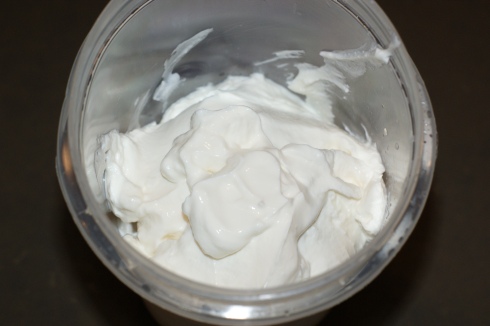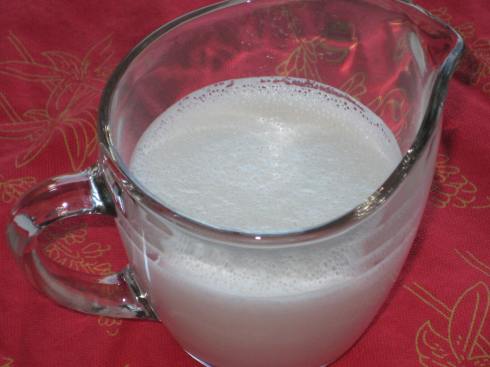You are currently browsing the category archive for the ‘Cream’ category.
Yogurt goes fast in our house. It’s eaten for breakfast and snack, mixed into dips and dressings, and topped on chili and soups. My favorite way of eating it is unsweetened Greek yogurt with berries and bananas or raisins and slice almonds. The thing is Greek yogurt is more expensive than its runnier counter parts. And most chain supermarkets don’t carry the full fat variety. So it’s non-fat or low-fat yogurt mixed with some other gunky fat-replacer or stabilizer. They also have lots of sugar. After seeing AndreAnna’s yummy post on homemade yogurt at Life as A Plate, I figured I can make it myself, hopefully save some money and get a pretty decent product.
When searching for yogurt making methods, I had no luck finding one that didn’t require cooking the milk first. All the recipes start with pasteurized milk which is followed by further cooking the milk. Why? I imagine it’s because you are killing off any unfriendly bacteria that may compete with or impede the friendly, yogurt-making kind, but no where does it say so in any of the recipes or blogs I found. Even more curious is that all the buttermilk or sour cream instructions I dug up just have you mix the milk or cream with the starter and leave it at room temperature to culture. I totally get why you’d need to heat the milk if you were using raw milk since it has yeasts and other organisms not found in pasteurized milk. I tried using raw milk, without cooking it, and I don’t recommend it. It turned out more like kefir and a bit cheesy.
There are two reasons I don’t want to cook the milk, the most important of which is I don’t want to go through the extra step. I’m on a path to simplify. The other reason is I don’t see the need for it. I’m already buying pasteurized milk and there is no fooling around with it between the time I open the carton to the time it meets the other ingredients, so I am not worried about contamination. I was determined to skip straight to the culturing part and see what happens. The worst is the milk doesn’t magically turn into yogurt or it smells funky and I won’t do it again. But that didn’t happen. I made perfectly good yogurt with the first batch and every one after that (well, except for the kefiry batch).
There are several methods for preparing your own yogurt and they all require time and a warm place. That can be done with a heating pad, an insulated cooler, a slow cooker, a yogurt maker, a warm oven or a dehydrator. I have a dehydrator so I opted for that which is a very good thing because it has a setting for yogurt. If I had to guess at the right temperature, my first batch either would have still been milk or probably baked.
No-Cook Yogurt
2 cups organic, pasteurized milk
1/2 to 1 cup organic heavy cream
1/4 to 1/2 cup starter yogurt (purchased or from a previous batch)
- Mix milk, cream and starter yogurt together in a bowl.
- Cover and place in a dehydrator or warm place (105 to 115 degrees F) for at least 8 hours and up to 24 hours.
- Chill yogurt in refrigerator to set up, a few hours to overnight.
- Strain yogurt using a paper towel or cheesecloth-lined colander over a bowl. The whey will drain out.
- Transfer yogurt to air tight container once it reaches the desired thickness. Keep in refrigerator for up to a week.
I have made this so many times now that I don’t even bother to measure anything out. I make the biggest batch that will fit in the dehydrator and just eyeball the ingredients. Feel free to adjust the ratio of milk to cream or omit the cream all together if you don’t mind a thinner yogurt. This unsweetened version is a blank canvas for all kinds of mix-ins: honey, jam, fresh fruit, granola, and more. My daughter loves tart yogurt and doesn’t need any sweetener to enjoy it. How will you eat it?
In the past I have always enjoyed my morning coffee with a healthy dose of half-and-half or heavy cream but lately I’ve been favoring a great coconut milk based creamer (So Delicious). But since I just ran out of my creamer and didn’t want to go to the store, I came up with my own. It’s super simple and quick, if you don’t count the soaking time. Cashews have a very creamy, smooth texture when blended so it makes a nice dairy substitute.
Cashew Creamer
Makes 3 cups
1 cup cashews, soaked several hours or overnight
2 cups water
1/8 teaspoon stevia (or 1 -2 teaspoons honey), optional
tiny pinch of salt
- Rinse and drain soaked cashews.
- Blend cashews with water, stevia and salt.
- Store in airtight container in the refrigerator.
There is no need to strain as you would with other nut milks. This can also be made into cashew milk by increasing the water to 3 or 4 cups. Other than coffee, cashew creamer can be used in smoothies and soups. So, if you are avoiding dairy or just want to try something different in your next cup of joe, give this a whirl.



